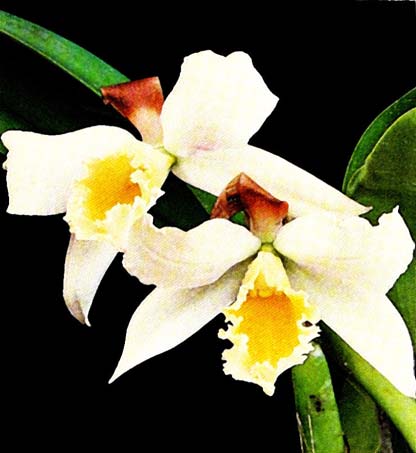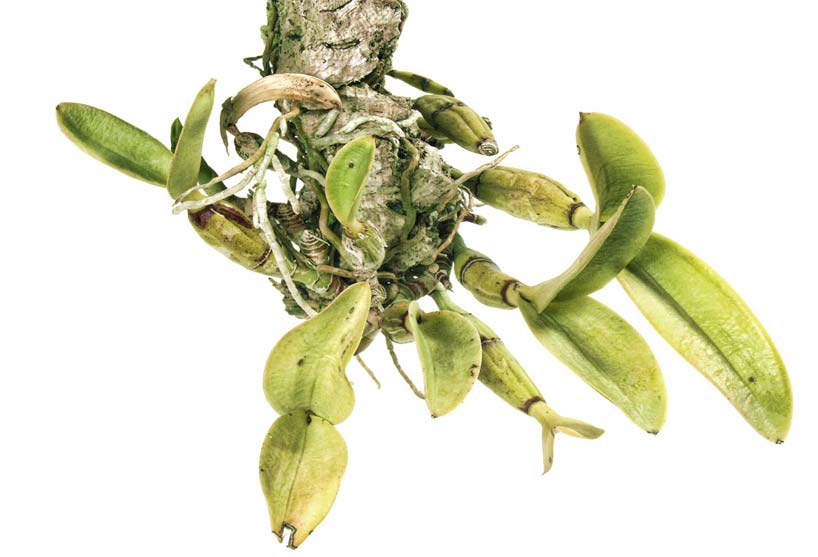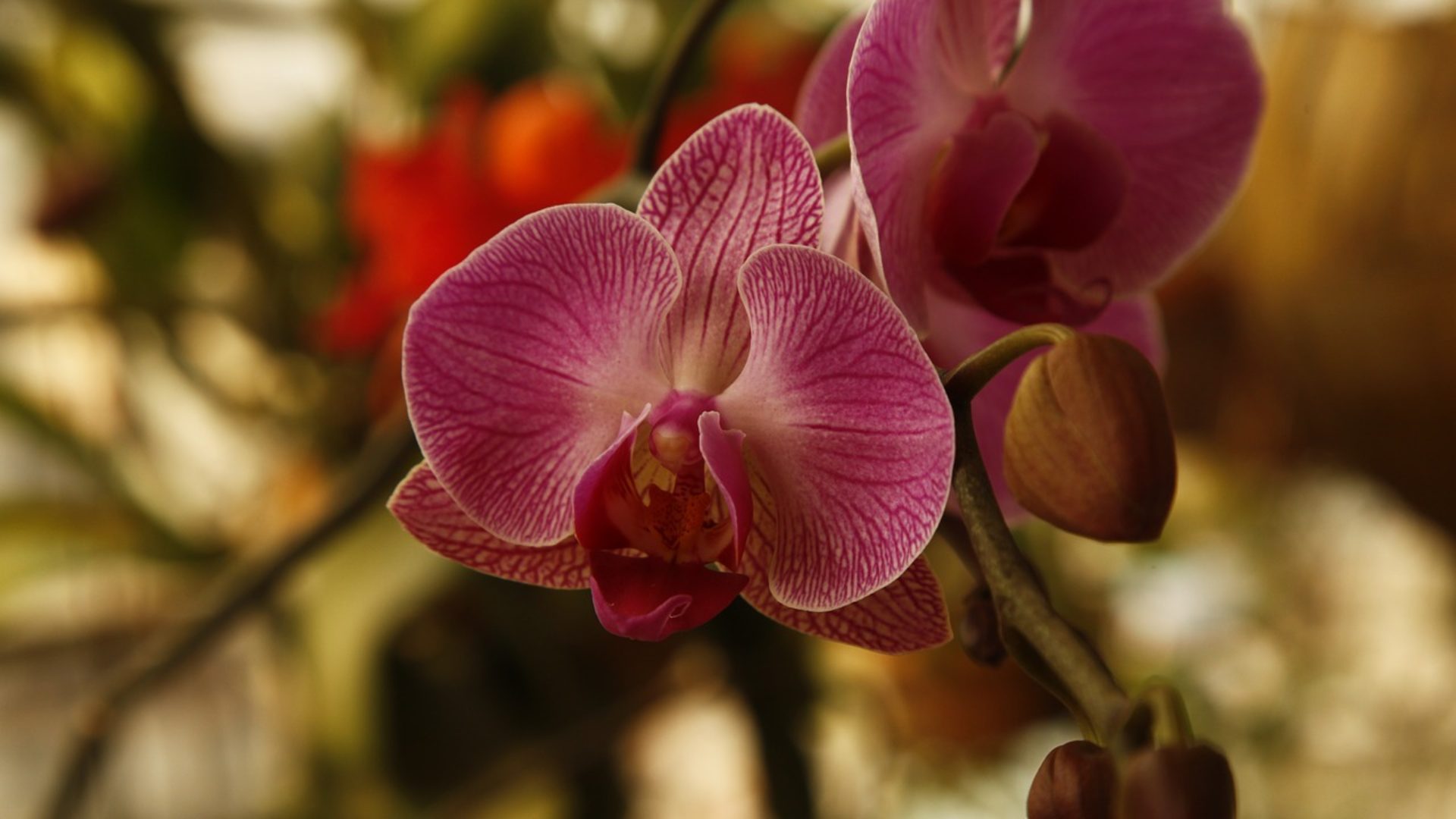Air Movement, Air Pollution and Humidity
From the air surrounding the plants, it takes in carbon dioxide for photosynthesis process. On the other hand, Oxygen is needed for respiration. Since Oxygen and Carbon dioxide levels in the air we breathe are adequate for plants and animals. The orchids hobbyist must ensure the growing area is free from toxic gases, circulating properly, and adequately moist.
 Sepal wilt on a Cattleya hybrid
Sepal wilt on a Cattleya hybrid
Ethylene Toxicity
Ethylene as a by-product of our modern industrial world has a detrimental effect on orchids even in a small quantities. This gas can cause a sepal or petal wilt (a kind of premature aging) in flowers. Sepal or petal wilt is associated primarily with Cattleyas and their hybrids. Flowers which expose to Ethylene will cause the sepal of newly-opended flowers losing their substance, becoming somewhat transplant. very soon, they will fold and eventually turn dry and become brown. Petals will respond in a similar manner when exposed to Ethylene at higher concentrations. Only at extremely hight concentration of long duration exposure does ethylene cause the flowers themselves to react adversely(yellowing of leaves being the likely results). Many Phalaenopsis and Dendrobiums are also highly susceptible to Ethylene damage. When exposed to Ethylene, the flower buds of these orchids cease development, turn yellow, and fall off. All the various orchid responses to ethylene can be observed towards the last day of its show. Ethylene from the smoking public and low humidity levels are probably in large proportion responsible for the short life of an orchid show. Ethylene is a result of the incomplete combustion of a fuel, commonly from a running car engine and poorly or malfunctioned ventilated heaters. The new and efficient heaters on the market today are safer to use for orchids. They emit less such toxic gases by burning fuel more thoroughly than their predecessor. So, all practical devices which involve with burning something should be suspected to protect orchids in flowers. The exhaust or smoke from them should be kept as far away from the growing area as possible. The heaters used directly with the orchids should be thoroughly investigated to ensure they do not emit ethylene.
Air Movement
Once you have assured your orchids of ethylene-free air, the next consideration should be air movement. Air in constant motion is beneficial to orchids. It is an effective means of equalizing ambient conditions. if air is curculating around the orchids, pockets of hot and cold air, low and high humidity, are less probably to develop. When the air is still, the blanket of insulating air clings to the leaf and prevent cooling to the considerable degree. on the opposite side, moving air is excellent means of conveying heat. It picks up the heat by direct contact and carries it away by keeping good moving air across the leaves. Moving air also has a drying capability. It can help in terms of disease control, because water left on the leaves or flowers for any duration creates condition conducive to fungal or bacterial attack. Ordinary fans can be used to get the air moving around your orchids in confined growing area. More average-size household fans can be used for window areas. They should not be aimed directly on the plants unless at the low speed. Otherwise, the plants can be damaged by heavy winds. For larger growing areas, the kind of ceiling fans would be better able to move the larger volumes of air involved. Naturally, openning several windows, without too drastic temperature change, can cause significant cross-ventiation and air movement. Open windows can favorably influence the humidity levels in the growing area, if the air is more humid outside. In greenhouses during the winter, openning vents can cause a loss of some humidity escaping with the rising warm greenhouse air.
Humidity
Moisture in the air, along with air movement and temperature, has a huge influence on the transpiration rate of a plant. Low humidity and high temperature can cause the ochids lose water through transpiration rate more than it can take up water through their root, leading to varying degrees of desiccation and wilting. Too high humidity without greenhouse is detrimental for the health of the orchids, but an atmosphere near saturation(100% humidity), and stagnant, can lead to water forming on the leaves and flowers, and to the very slow drying of potting media.
 Insufficient air movement and high humidity can foster Botrytis flower blight
Insufficient air movement and high humidity can foster Botrytis flower blight
Recommendations for suitable level of humidity is at around the figure of 60% humidity for good orchid. Humidity level is greatly determined by the temperature. The warmer the temperature, the more moisture which is added for maintaining proper relative humidity. Providing acceptable humidity is not a problem in night time when temperatures is cold and transpiration rate is at a minimum. Water molecules must take apart from each other in order to become air borne and provide humidity. Naturally, there is a process called evaporation which water molecules exposed to air are gradually separate from the pack and join the atmosphere. Level of humidity depends on the rate and number of water molecules liberated to the surrounding air. Porous gravel generates reasonable amounts of humidity in this way by absorbing water, thereby exposing it to more air. Orchids themselves in large numbers and in freshly watered media, do at least partially contribute to the overall humidity in a similar way. Some humidifier create humidity by atomizing water into smaller amounts, creating a fine mist. Others generate humidity by exposing small droplets of water to large volumes of air. this method is by blowing air through fibrous pad moistened in traveling through a tray of water.
Evaporative coolers use the principle that water need to absorb heat and energy to go from liquid state to gaseous state consequently, cooling the air or surface involved. Syringing and misting the orchids use this principle. This method can momentarily cool the leaf and raise humidity but if done frequently, the beneficial effects are not worth the greater risk of spreading disease, and the nuisance of residual mineral accumulating on the leaves. Misting is worthwhile for outdoor growers in terms of retarding heat build-up and its resulting sunburn during hot, still, sunny weather. Maintaining humidity indoors is by using a good humidifier but there is a few things to be aware of. Heated or air-conditioned air is low in humidity and can dry the air of growing area quickly. Humidifier will work overtime during cold weather when the heat is on frequently. In winter time, cold surface window glass will draw water out of the air the reverse process of evaporation condensation. Double glazing can be used to reduce this occurrence by moderating surface temperature. Since, humidity levels lower immediately as temperature rise, unless additional moisture is added to the air. in the opposite, relative humidity rises as temperature drops such as in nighttime hours. So, most efforts toward increasing humidity must be taken during warmer and bright daylight hours especially, when heat or air-conditioned is on. Orchid grower should be strive for gentle movement of clean moist air around the orchids. This practice can eliminate or at leat moderate the extremes which can develop in the growing environments.
 Low humidity conditions are specially trying for mounted orchids such as Cattleya hybrid
Low humidity conditions are specially trying for mounted orchids such as Cattleya hybrid
Humid and moving air can cooling leaf and reduce transpiration rate and water stress in the case of high light and warm temperatures. Light, air movement, humidity, and temperature are the factors which determine the water and nutrient needs of orchids, and therefore the watering and fertilizing practices.


